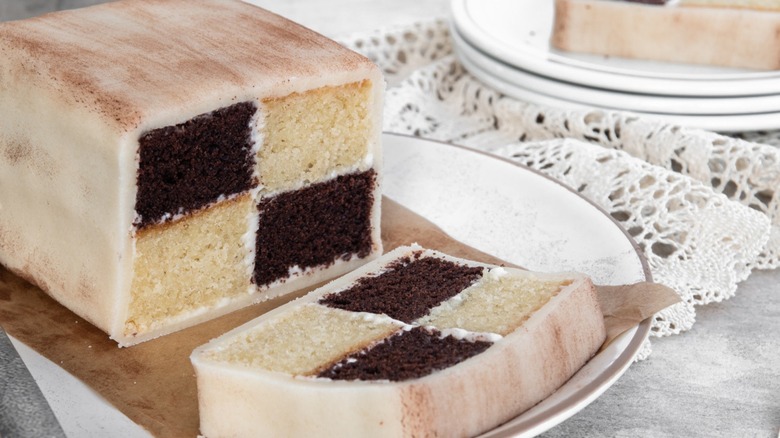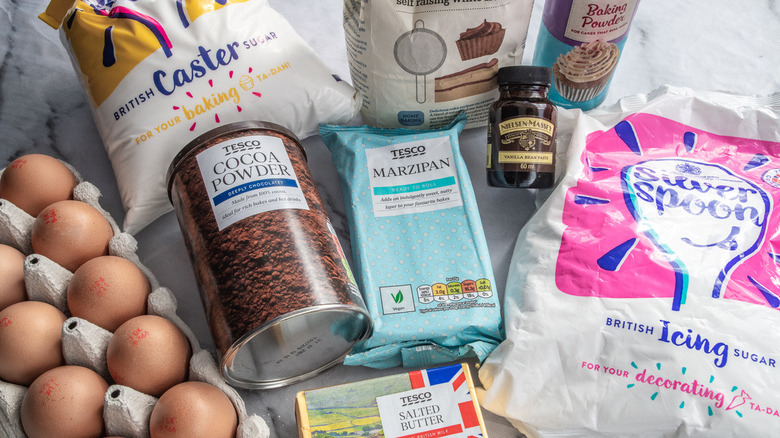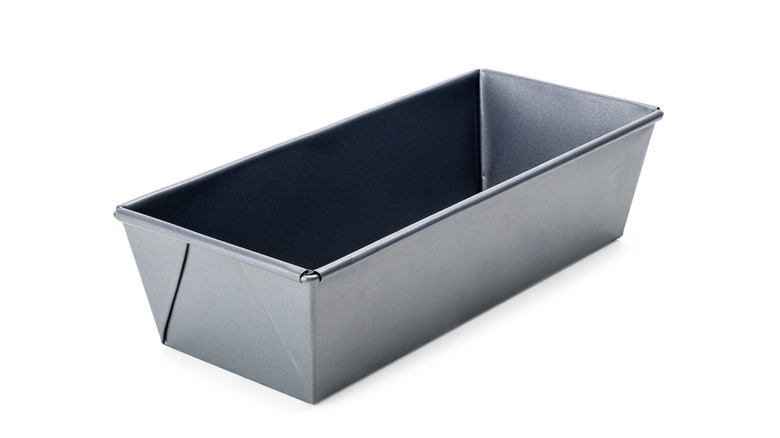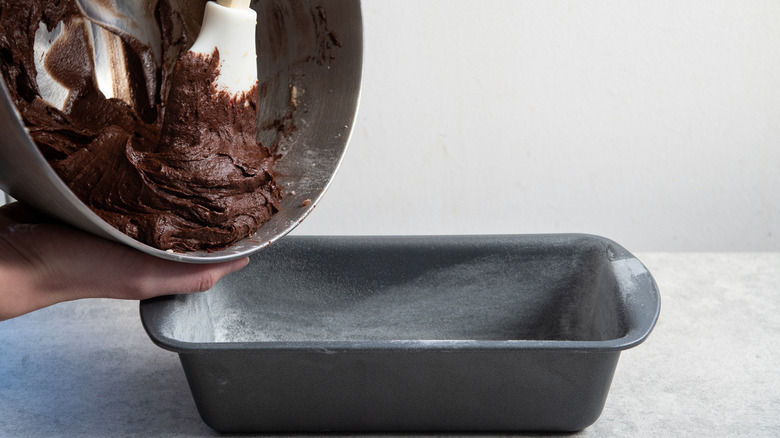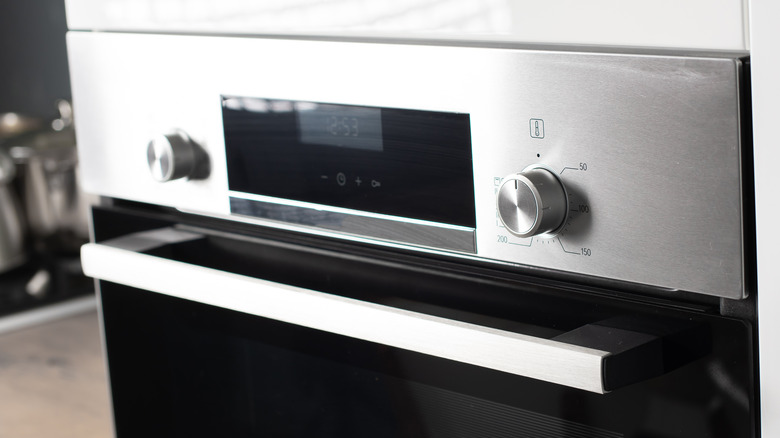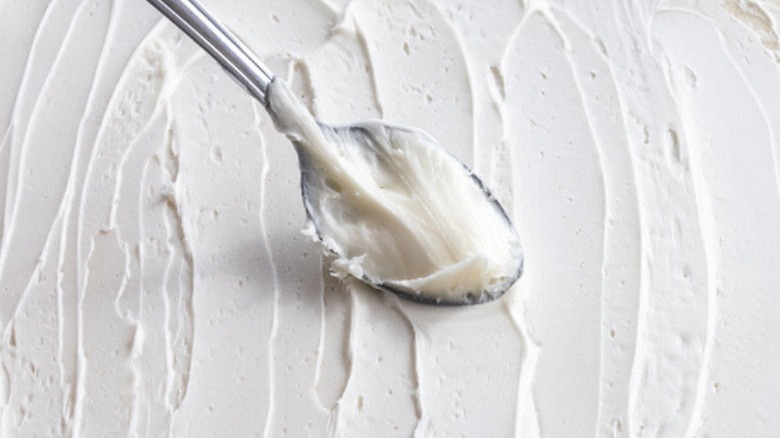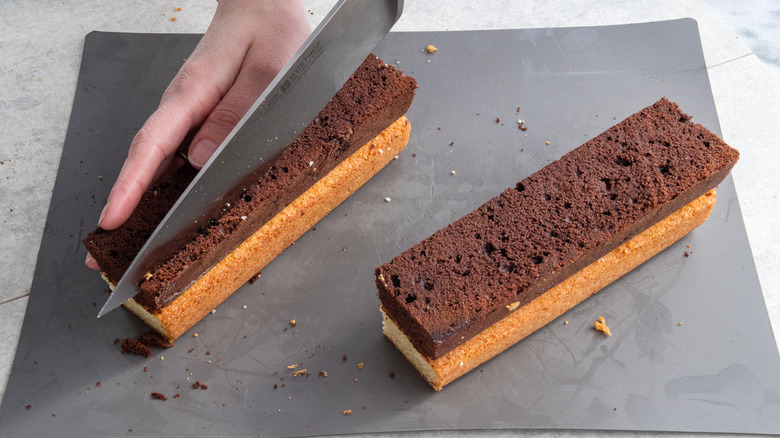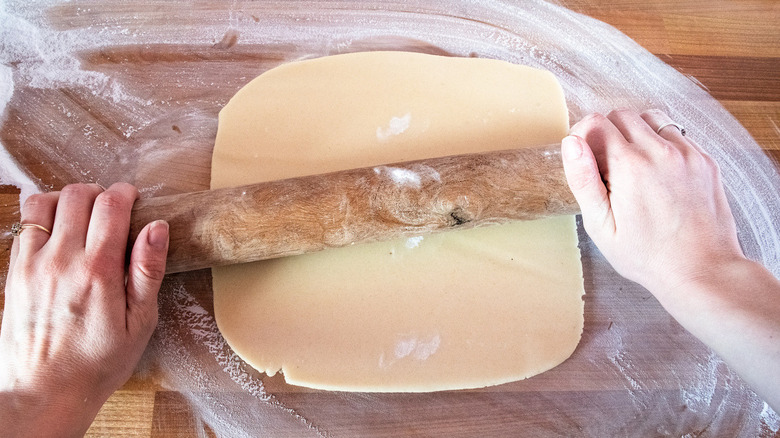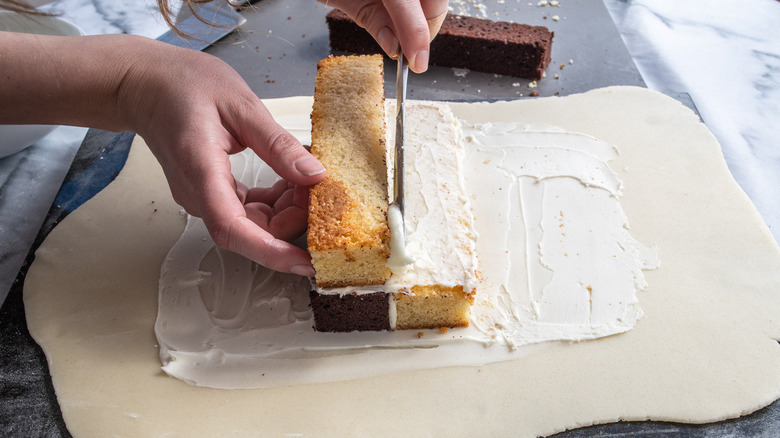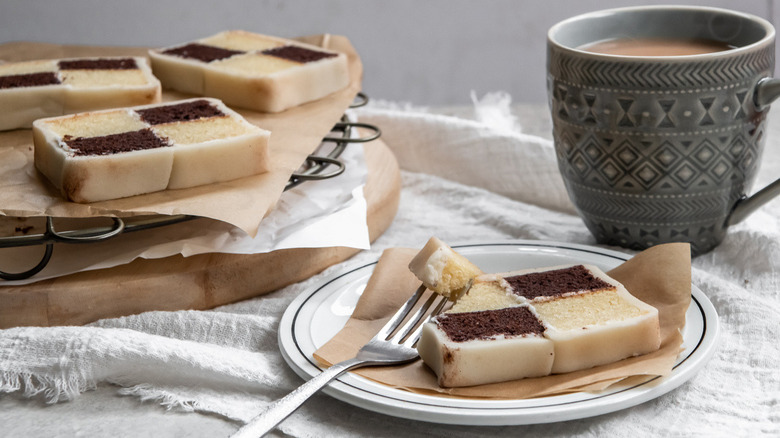Chocolate Battenberg Cake Recipe
We may receive a commission on purchases made from links.
If you're a fan of The Great British Baking Show, then you may have seen contestants try to create a lovely, yet complicated-looking, checkerboard-patterned cake called Battenberg (sometimes spelled Battenburg). This beloved British cake may date back to the reign of the notoriously sweet-toothed Queen Victoria, a monarch who was known for her fondness for pastries. Legend has it that the cake was made for the 1884 marriage of Prince Louis of Battenberg and Queen Victoria's granddaughter, Princess Victoria (via British Food and Travel). But, according to English Heritage, there's no real evidence for this as the first published recipe dates to 1898. The earliest versions of the cake were made up of 9 squares, but mid-century mass production reduced the number to the simpler 4-square pattern we know today.
The squares of a traditional Battenberg are pink and yellow, but the cake itself is a plain white sponge. There's no reason not to give tradition a tweak from time to time, though, especially if the great Mary Berry gives her okay. One of her favorite GBBS challenges (via The Guardian) involved a coffee and walnut Battenberg cake, and she'd be sure to approve of recipe developer Jennine Bryant's chocolate version as well. We're certain that Queen Elizabeth II would absolutely love this cake, so now you know what to serve next time she drops by for afternoon tea.
Assemble the ingredients for chocolate Battenberg cake
At first glance, this recipe may call for several ingredients that aren't all that easy to come by in the U.S., like caster sugar. This type of sugar is called for in many British recipes, and it's basically just superfine sugar. If you can't find the superfine stuff in the grocery store, you can always order it online, but this won't come cheap. (Amazon sells a 2 ½ pound bag for $13.00.) If you want to save the time and expense of ordering this ingredient, AllRecipes offers an alternative: Put the required amount of granulated sugar in a blender, and pulse it two or three times. Voilà! It's now superfine.
Self-rising flour is easier to come by, and it's also simple to DIY by mixing 1 ½ teaspoons of baking powder and ½ teaspoon of salt into 1 cup of all-purpose flour. As for icing sugar, that's just the British term for confectioner's (powdered) sugar. You'll also need butter (softened), eggs, baking powder, cocoa powder, and salt, and a little bit of milk may be needed to thin the batter and frosting. One all-important ingredient you probably will need to order, since it would be insanely difficult to produce a suitably smooth homemade version, is ready-to-roll marzipan. You'll need a 1-pound package. Amazon sells it for about $20, but you simply can't have a Battenberg cake without this delicious candy coating that's so much tastier than fondant.
Prepare the pans
To bake the two cakes used to make that Battenberg checker pattern, you'll need two pans of exactly the same size. Bryant says she uses loaf pans measuring 8x4 inches. Grease the pans with a little bit of butter or oil, then cut two pieces of parchment paper to line the bottoms of each one. Lining the pans, Bryant says, will allow you to "easily release the cakes once [they're] baked."
No parchment paper on hand? You can actually use wax paper as well. While you should never line a cookie sheet with wax paper since the bits of paper between the cookies might burn, here, the paper won't be directly exposed to heat so it's fine for use as a liner. After you prep the pans, but before you begin the batter, go ahead and preheat the oven to 375 degrees Fahrenheit.
Mix the two different cake batters
To make the white sponge cake, beat together ¼ cup plus 3 tablespoons of caster/superfine (or just plain granulated) sugar with 7 tablespoons of softened butter, then stir in 2 eggs one at a time until thoroughly blended. Mix ¾ cup plus 2 tablespoons of flour, ½ teaspoon of baking powder, and a tiny pinch of salt together, then add the dry ingredients to the wet ones and stir until well combined. If the mixture is too thick, you may need to add 1 tablespoon of milk. Once the batter is ready, pour it into one of the prepared loaf pans.
For the chocolate sponge cake, beat together ¼ cup plus 3 tablespoons of caster/superfine sugar with 7 tablespoons of softened butter, and again stir in 2 eggs one at a time until thoroughly blended. Mix ¾ cup plus 2 tablespoons flour, ½ teaspoon baking powder, another tiny pinch of salt, and 2 tablespoons of cocoa powder, then add to the egg mix. Again, you may need an added tablespoon of milk to thin out the batter. Pour this batter into the other prepared loaf pan, then check to make sure the oven has reached its proper temperature.
Bake the cakes
Bake both cakes for 25 minutes. You can check to see if they're done by pressing very lightly on the top of each cake. As Bryant says, "If it springs back, the cake is ready to come out of the oven." If, on the other hand, you press down and it leaves a little dent, the cake needs a few more minutes of baking time.
Once you're sure the cakes are done cooking, take them out of the oven and let them sit in the pans for 10 minutes. After 10 minutes, you'll need to turn them out onto a wire rack. Be very careful as you remove them from the pans! If either one breaks or fall apart, it won't be much use for making a Battenberg cake, although it can always be repurposed in an equally British (and equally yummy) trifle.
Prepare the frosting
While a traditional Battenberg sandwiches together the different-flavored layers of cake with apricot jam, Bryant says using buttercream frosting instead "made the Battenberg a little more creamy overall" and says she feels "the buttercream complements and brings out the chocolate flavor where the jelly would contrast [with] it." If you're a jam fan, though, you can feel free to revert to the original filler, or you could even go wild and use something really different like strawberry or raspberry jam.
If you do decide to go with the buttercream frosting, you can make it while the cakes cool. Put the remaining 7 tablespoons of softened butter in a bowl (Bryant uses a stand mixer, but you can mix by hand as well) and gradually add in the 1 ¾ cups of confectioner's sugar. Mix until the butter and sugar are thoroughly combined and you have a smooth frosting. If needed, you can thin the frosting out with another tablespoon of milk.
Slice the two cakes
Once both of the cakes are thoroughly cooled, you can cut them, but don't rush this process! If they're even a little bit warm, you won't get a nice even cut, and a Battenberg cake cannot hide any structural errors under an extra layer of frosting. Place one of the cakes on top of the other, then take a sharp knife and cut both cakes down the middle lengthwise. Line up each of the 4 cake sections and trim them to the same length, something Bryant says "ensures that the sponges will all be the same size."
Roll out the marzipan
Now's the time to roll out that ready-to-roll marzipan. Before you take it out of the package, prep your work surface by sprinkling it lightly with confectioner's sugar. This will keep the marzipan from sticking, but will taste better than using regular flour. Roll out the marzipan using a rolling pin, rotating the marzipan every so often to make sure you're rolling it to an even thickness. You want the finished product to be about as thick as a coin.
To roll the marzipan, first prepare your area by sprinkling the surface with icing sugar so that the marzipan doesn't stick. Roll it out using a rolling pin, periodically rotating the marzipan to make sure it stays even. When it's rolled out, Bryant says it should be "about the thickness of a coin" — one of the thicker ones, like a nickel or a quarter. It should also be about 8x12 inches in order to cover the cake.
Assemble the Battenberg cake, checkerboard-style
Now comes the tricky part: putting it all together. Start by spreading a layer of frosting on top of the marzipan, then adding a layer with one piece of white and one piece of chocolate cake side by side. Spread a little frosting between the cakes where they touch so they'll stick together, too. Then, spread more frosting on top of the cake layer, and place the remaining chocolate cake on top of the white one and vice-versa. This, Bryant says, will give you "the classic Battenberg checker effect."
Spread more of the frosting all around the outsides of the cake, then fold half of the marzipan up over the top and trim it so it just meets the center. Don't throw out the excess marzipan! You can enjoy it as a sweet little lagniappe, or you can save it to make edible decorations, either to embellish your Battenberg cake or for some later baking project. Repeat the fold-and-trim process with the other side of the marzipan, then pinch both sides together to seal.
Flip the Battenberg cake over so the seam is on the bottom, then use your sharp knife again to trim the edges of the marzipan and, if needed, a little bit of the sponge cake. This final trim, Bryant assures us, "will give the Battenberg nice smooth, flat ends to best show off the beautiful checkerboard cake pattern."
Show off your beautiful Battenberg cake
Bryant says that in the U.K., where Battenberg cake isn't such a rarity, "We'd normally have Battenberg with afternoon tea ... alongside sandwiches, scones, fresh fruit, etc." She says it's also something people tend to take on picnics. (Wow, and we thought we were being fancy by packing both brownies and peanut butter cookies in our baskets!)
Here in the U.S., where such artistic cakes are harder to come by, you may prefer to have an admiring audience for your elegant dessert. Consider serving the Battenberg cake on your finest china with tea served in your daintiest teacups. In fact, you could even crack open a bottle of champagne. While your home may lack the opulence of Windsor Castle, for one afternoon, at least, you can have a teatime fit for a chocolate-loving queen.
The chocolate Battenberg cake you didn't know you needed
Consider serving the Battenberg cake on your finest china with tea served in your daintiest teacups. In fact, you could even crack open a bottle of champagne.
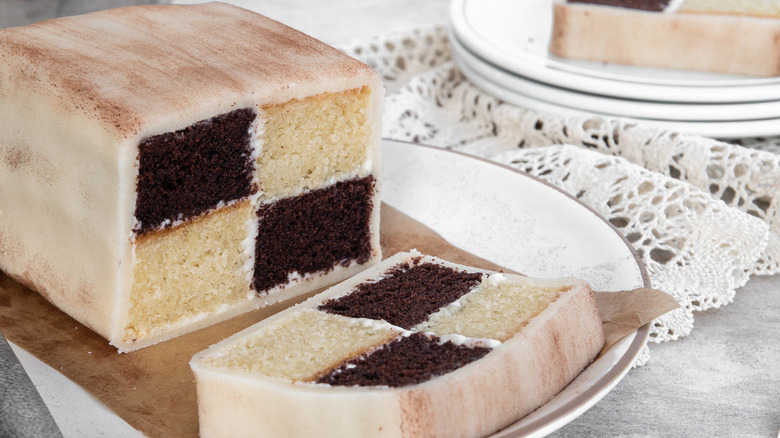
Ingredients
- 7 ounces (7/8 cup or ¾ cup plus 2 tablespoons) superfine (caster) sugar
- 10 ½ ounces (2 sticks plus 5 tablespoons) unsalted butter
- 4 eggs
- 7 ounces (1 ¾ cups) self-rising flour
- 1 tablespoon baking powder
- 2 tablespoons cocoa powder
- 7 ounces (1 ¾ cups) confectioner's (icing) sugar
- 1-pound package ready roll marzipan
- pinch salt
Optional Ingredients
- 4 tablespoons milk, if needed
Directions
- Prepare two 8x4-inch loaf pans. Grease them with butter and then line the bottoms with parchment or wax paper. Preheat oven to 375 degrees Fahrenheit.
- To make the white sponge cake, beat together ¼ cup plus 3 tablespoons of caster or superfine sugar with 7 tablespoons of softened butter. Stir in 2 eggs until thoroughly blended. Mix ¾ cup plus 2 tablespoons of flour, ½ teaspoon of baking powder, and a tiny pinch of salt together, then add the dry ingredients to the wet ones and stir until well combined. If the mixture is too thick, add a tablespoon of milk. Pour the batter into a prepared loaf pan.
- To make the chocolate sponge cake, beat together ¼ cup plus 3 tablespoons of caster or superfine sugar with 7 tablespoons of softened butter. Stir in two eggs until thoroughly blended. Mix ¾ cup plus 2 tablespoons of flour, ½ teaspoon of baking powder, a tiny pinch of salt, and 2 tablespoons of cocoa powder together, then add the dry ingredients to the wet ones and stir until well combined. If the mixture is too thick, add a tablespoon of milk. Pour the batter into a prepared loaf pan.
- Bake the cakes for 25 minutes or until done. Let cool for 10 minutes, then remove from pans and cool completely on a wire rack.
- To make the buttercream, dice remaining 7 tablespoons of softened butter into a bowl and slowly add the confectioner's sugar. Mix by hand or with a stand mixer until well-combined and smooth. Thin the frosting with a tablespoon of milk if necessary.
- Place cooled cakes one on top of the other and use a sharp knife to cut down the middle lengthwise. Line the cake segments up and trim the ends and sides until they are of equal length.
- Prepare rolling surface by lightly sprinkling with confectioner's sugar. Roll the marzipan out using a rolling pin, rotating to make sure it stays even. Roll it out to a rectangle about 8x12 inches and about as thick as a quarter.
- Spread a layer of frosting over the marzipan, and add the first layer of white and chocolate cake segments. Spread frosting between the segments, as well.
- Spread another layer of frosting over the first cake layer, then place the second chocolate cake layer on the white cake, and the second white cake layer onto the chocolate cake.
- Spread remaining frosting around the outside of the Battenberg cake, then fold half of the marzipan over the top of the Battenberg and cut it along the center. Do the same on the other side so that the marzipan meets in the middle at the top. Pinch marzipan together to seal it, then turn the cake over so the seam is on the bottom.
- Use a sharp knife to trim the edges of the marzipan off the ends of the Battenberg cake.
